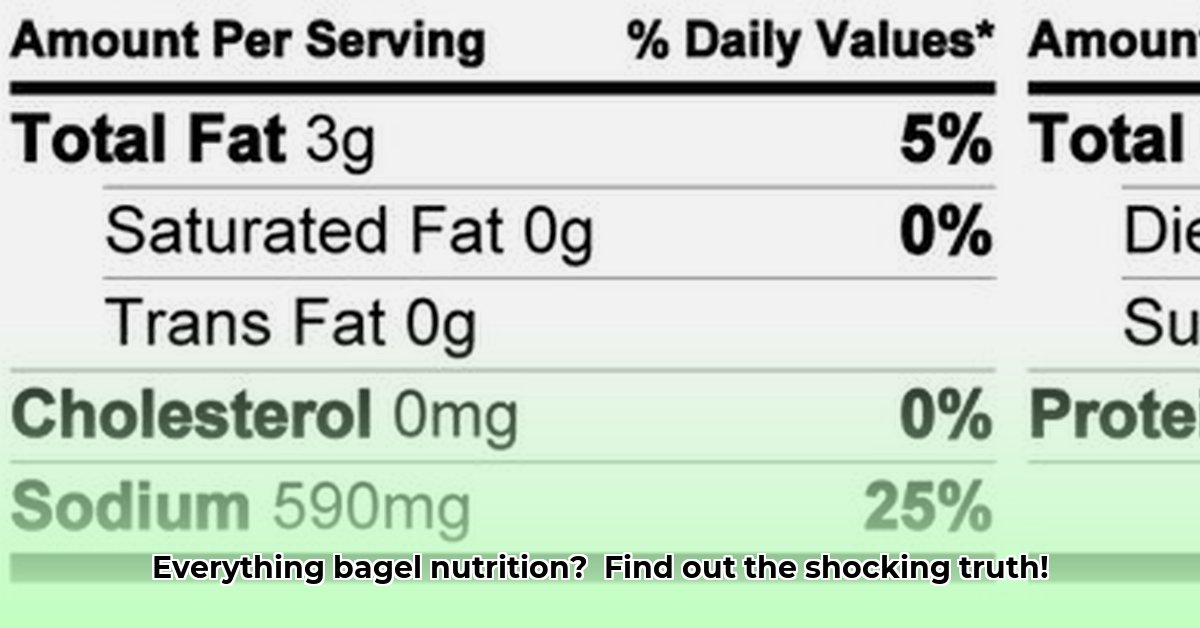Love everything bagels? You’re not alone! But have you ever wondered exactly what’s in that delicious, sesame-seeded goodness? Turns out, the nutritional info can vary quite a bit depending on the brand. For more on comparing processed food nutrition, check out this article on [egg roll nutrition](https://chaztin.com/egg-roll-nutrition-facts/). This article breaks down the numbers – calories, carbs, fat, the works – from different everything bagel makers so you can see how they compare. We’ll keep it simple and easy to understand, so you can make choices that fit your lifestyle.
Everything Bagel Nutrition: A Tale of Two Brands (and More!)
Let’s be honest, everything bagels are irresistible. That sesame-poppy-onion-garlic symphony is hard to say no to. But before you reach for another, let’s peek under the hood and examine their nutritional makeup. We’re about to dive into the surprisingly variable world of everything bagel nutrition, with a spotlight on sodium levels, sugar surprises, and portion size pitfalls.
The Calorie Count Quandary: Why Numbers Don’t Always Add Up
First up: calories. Seems simple, right? Not so fast. Our research uncovered a calorie range of 270 to nearly 300 per EVERYTHING bagel. That difference can matter if you’re mindful of your intake. Why the discrepancy? Bagel size is a major factor – is it a mini or a monster? Ingredient variations also play a role. Seed types and amounts, dough recipes, and even baking methods all impact the calorie tally. Plus, nutrition facts are often estimates, not precise lab results. This highlights the importance of mindful portion control for accurate calorie tracking.
Macro Matters: Carbs, Fats, and Proteins – What You Need to Know
Calories are just the beginning. Let’s zoom in on macronutrients: carbohydrates, fats, and proteins. Carbs are consistently high, hovering around 55 grams per bagel, making them a quick energy source. But remember, this can affect blood sugar levels. Fat and protein levels show more variation. Some sources list as low as 1.4 grams of fat, while others approach 2.5 grams. Protein ranges from 10 to 11 grams. Are these simply measurement inconsistencies, or do different recipes account for these differences? The answer calls for careful scrutiny of macro breakdowns to align with dietary goals.
Salt Shock: The Sodium Situation
Don’t forget sodium! You might be surprised by the salt lurking in your everything bagel. Our data reveals a range of 440 to over 500 milligrams of sodium per bagel. That’s significant, given recommended daily limits. If you’re watching your sodium intake for health reasons, pay close attention to nutrition labels. Many people are unaware of the hidden dangers of high-sodium foods, even seemingly harmless ones.
The Data Detective’s Dilemma: Unreliable Nutritional Information
Pinpointing reliable everything bagel nutrition facts proved trickier than we anticipated. We found inconsistencies across sources, with some brands offering detailed data and others providing little to no information. This lack of standardization makes direct comparisons difficult and points to a larger issue with food manufacturers’ nutritional disclosures. This situation emphasizes the need for greater consistency and transparency in labeling, improved measurement standards, and stricter regulatory oversight. This amplifies the need for greater transparency in labeling practices from food manufacturers.
What It All Means: Practical Implications for You
What does this mean for you, the everything bagel enthusiast? It underscores the importance of reading labels carefully. Don’t solely rely on online databases; double-check the packaging for the most up-to-date data. Remember that portion size matters. A smaller bagel equates to fewer calories and a lower nutrient load. And bear in mind that nutritional information is often an estimate, subject to variations in ingredient sourcing, processing techniques, and measurement methodologies. Therefore, consumers must be proactive and informed label readers to navigate such complexities.
A Call for Clarity: Towards Standardized Bagel Data
Ultimately, we need brands to adopt more consistent reporting practices and standardized methodologies. Consumers deserve clear, reliable information to make informed decisions. Until then, become a nutrition detective, meticulously examining labels and acknowledging the limitations of the available data. Hopefully, further research will illuminate the nuances of everything bagel nutrition. Striving for standardized and more accurate nutritional data remains crucial for empowering consumer choice.
Everything Bagel Nutrition: A Side-by-Side Snapshot
Here’s a comparison, acknowledging that these are samples and don’t encompass the entire market:
| Source | Calories (approx.) | Fat (g) (approx.) | Sodium (mg) (approx.) | Carbohydrates (g) (approx.) | Protein (g) (approx.) |
|---|---|---|---|---|---|
| Nutritionix | 277 | 1.4 | 443 | 55 | 11 |
| FatSecret | 279 | 1.7 | 516 | 55 | 11 |
| Panera Bread | 290 | 1.5 | N/A | 58 | N/A |
| Starbucks | 270 | 2.5 | N/A | N/A | N/A |
Note: “N/A” indicates unavailable data. Actual values may vary based on supplier differences; always verify the values on the product label.
Cracking the Code: How to Compare Everything Bagels Across Brands for Optimal Nutrition
Key Takeaways:
- Everything bagels exhibit notable nutritional differences across brands.
- Sodium, carbohydrate, and calorie levels are generally high but differ in specifics.
- Fiber content is often low, depending on flour type.
- Micronutrient levels from toppings vary considerably.
- Choosing whole-grain options and controlling portions are critical.
Let’s be real: everything bagels are addictive. But are they nutritious? It depends! Their nutritional profile can vary widely based on the baker. How to compare everything bagel nutrition across diverse brands is a valid question. Let’s unpack what to look for, with attention to ingredient sourcing and preparation methods.
Decode the Label: Essential Elements for Scrutiny
First, grab those nutrition labels. They’re your map to navigate the differences between brands. What should you focus on?
- Serving Size: This is critical. Bagels differ in size. Compare apples to apples by always checking the serving size. Larger bagels naturally have more calories, carbs, and other nutrients.
- Calories: A good starting point for overall calories. Expect 275-300 calories per bagel.
- Carbohydrates: Everything bagels are largely carbs, so anticipate a high number (50-60 grams). Pay attention to the type of carbohydrate. Whole-grain bagels contain more fiber, making them a healthier choice.
- Fiber: Low fiber content (1-3 grams) suggests refined flour use. Aim for higher fiber to improve digestion and blood sugar management.
- Sodium: Mind the sodium. Everything bagels tend to be high in sodium, possibly exceeding 400-600 mg per bagel. This is essential for individuals monitoring sodium intake.
- Fat and Protein: These vary based on added ingredients. Check for reasonable levels of both.
- Micronutrients: Seeds and seasonings contribute some vitamins and minerals, but amounts vary across brands. Therefore, don’t rely on them for your daily needs. Always remember that labels exist to guide you, not confuse you.
Brand Comparison: A Practical Approach
To compare brands effectively, use a spreadsheet! List each brand and fill in the nutritional data. This shows precisely how nutritional content varies across brands. A structured approach allows for efficient side-by-side comparisons.
Healthier Choices: Smart Strategies for Enjoying Bagels
How can you make smarter choices?
- Choose Whole-Grain Options: Select bagels made with whole wheat flour or other whole grains. These usually have more fiber, aiding digestion and blood sugar control.
- Practice Portion Control: Reduce portion size by slicing everything bagels and enjoying them in moderation. Consider open-faced sandwiches or smaller bagel options.
- Mind the Toppings: Load up on nutritious toppings like vegetables, lean protein, and healthy fats. Avocado, smoked salmon, hummus, or a fried egg can transform a carb-heavy bagel into a more balanced meal. Be cautious of high-fat cream cheese or sugary spreads, which can negate the healthfulness of the bagel.
- Seek Lower-Sodium Alternatives: If you’re sodium-sensitive, look for brands that explicitly offer low-sodium versions of everything bagels.
- Make Your Own: For ultimate control over ingredients, consider making everything bagels at home. This allows you to use whole-wheat flour, reduce the amount of salt, and customize the toppings to your liking.
Final Thoughts: Conscious Bagel Consumption
Everything bagels, while delicious, require conscious consumption. By becoming a label-reading pro and making smart choices, you can enjoy them as part of a balanced diet. Remember to consider portion sizes, toppings, and frequency of consumption. Enjoy your everything bagel, but do so with your nutritional awareness activated!
- Bento Box Trays Streamline Restaurant Meal Presentation and Transport - December 13, 2025
- Plastic Bento Boxes Face Scrutiny Over Sustainability Impacts - December 11, 2025
- Bento Tray Revolutionizes Organized Meal Transport and Presentation - December 10, 2025










